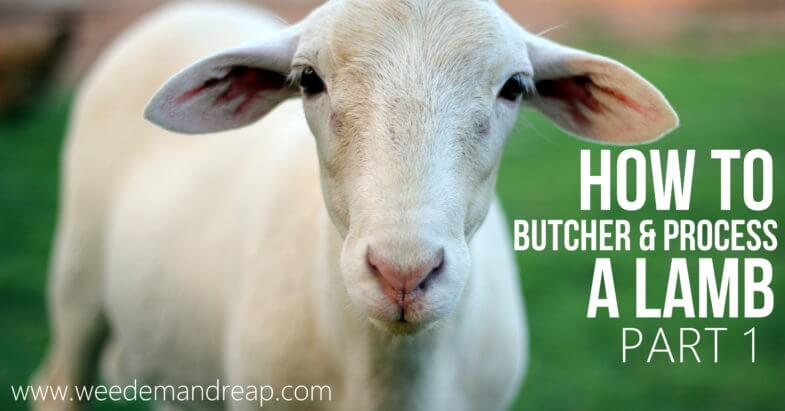
Heads up peeps! Today you’re going to learn how to butcher a lamb! There’s going to be blood, gore, and me dressed in flannel. It’s gonna be crazy, so let’s just jump right into it head first.
If butchering lambs is wrong then I don’t want to be right.
I get quite a bit of backlash when I start talking about butchering lambs, or posting pictures on my FB page of animals I plan on eating. I get that some people don’t agree with killing animals for food, I do. It’s sad to butcher an animal, and it should be sad. There’s sacrifice every time we eat, and whether it comes from a plant or an animal, its life is ended when we consume it.
Let’s start out with some “lamb butchering” facts here. We do not butcher baby lambs. Our lambs are full-grown, 10 months old, and weighing more than 150 pounds. Our lambs are big and wonderful, gentle animals. They aren’t technically called sheep until they reach 1 year of age.
But why are you butchering sweet adorable lambs?
Lambs are one of the most sustainable and affordable animals to raise for meat. They thrive on a diet of 100% grass, and only need a salt block and fresh water to complete their nutrition. Our lambs spend the their first 6 months with their mom until their mom naturally weans them, then our lambs enjoy the summer & fall mowing our lawn & turning our fresh grass into food for us. They are extremely gentle and easy to raise around children, and are the most affordable meat to raise, costing only about $1 a pound. You can read more on how we raise our lambs here.
I’ll admit, of all the animals here on the homestead, the lambs are my favorite. They are gentle, loving, and adorable. I definitely feel sad when butchering time comes and I’m extremely grateful for the nourishment they provide my family.
Here in Arizona, raising lambs is a traditional practice of the Native Americans who originated here. The Native Americans have been raising lambs & sheep for thousands of years, and this time around we were lucky to have an expert in Native American butchering practices come and teach us the method.
The Native American method begins with a prayer of giving thanks to our creator for this animal and the nourishment it’ll provide.
How to Butcher & Process a Lamb: Part 1
WARNING: These pictures have blood and guts (This is a butchering post after all). I’d suggest you look away or have your kids read you this part if you’re feeling squeamish.)
STEP 1 – Lay the lamb down on his side, tie all of his feet together, speak gently so he is not startled and quickly slice the jugular vein, so that the blood starts to drain and the lamb will soon pass out. After the lamb has died, you can remove the head and set it aside.
STEP 2 – Cut and pull back the skin around the hock of both back legs.
STEP 3 – Cut a slit in the connective tissue of the hock and tie a small rope or twine through each hock.
STEP 4 – Now you can hang the entire body of the lamb upside down by his hocks. Before you start cutting off the skin, see step 5.
STEP 5 – Go down to the neck, locate the esophagus tube and pull it tight.
STEP 6 – Using a sharp knife scrape the slippery membrane off of the esophagus.
STEP 7 – Tie the esophagus into a tight knot. This will prevent any digestive juices from the rumen leaking out and tainting your meat.
STEP 7 – Now, using your knife, work your way down skinning the lamb. You’ll gently slice between the skin and fat and pull as you go down.
STEP 8 – Keep working on it until you get to the neck area.
STEP 9 – Slice down the belly of the lamb allowing the entrails and organs to spill out.
STEP 10 – In the back of the lamb, you’ll need to detach the connective tissue around the end point of the intestine so it can fall out through the front.
STEP 11 – After the insides have all spilled out, now you can rinse the carcass off with water, getting rid of any fur.
That’s pretty much it! Not as hard as you’d think, right? Our first time we butchered a lamb, I had a difficult time with all those blood and guts, but now I’m a seasoned homesteader doing all kinds of gross things, including skinning lamb heads.
Yes, you heard me right. A roasted lamb head isn’t something I’ve brought myself to try, but in many cultures it’s a favorite dish. I decided to go for it and skin the lamb’s head just for my friend Mundo who helped us last time.
I decided to crop this picture. I’m not sure the world is ready to see a skinned lamb head just yet…
Stay tuned for next week’s Part 2, where I show how to break down the lamb into all the best cuts!
Have you ever butchered an animal? Are you ready to start raising grass-fed lamb now?
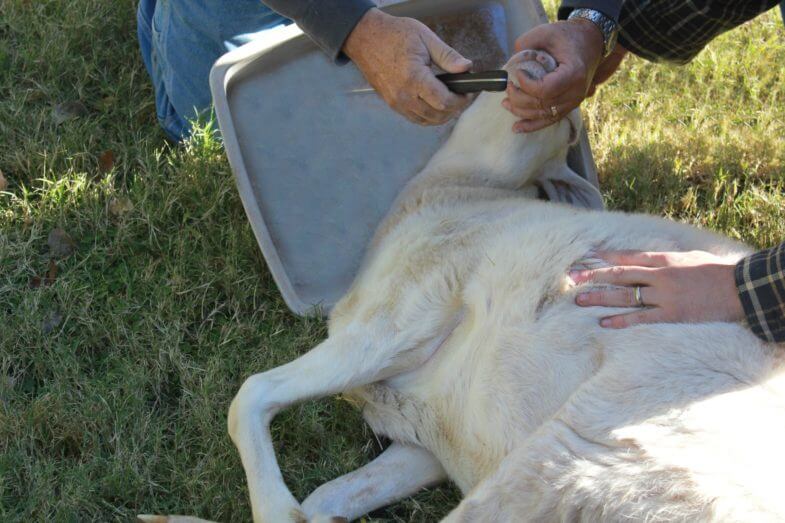
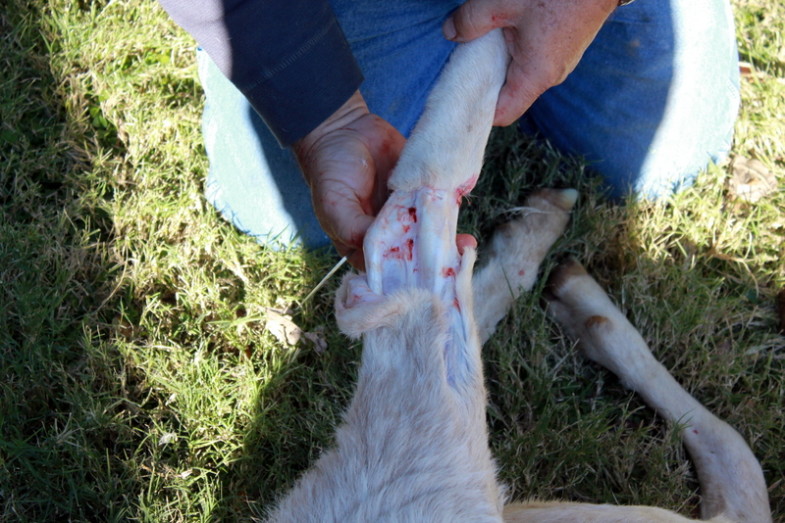
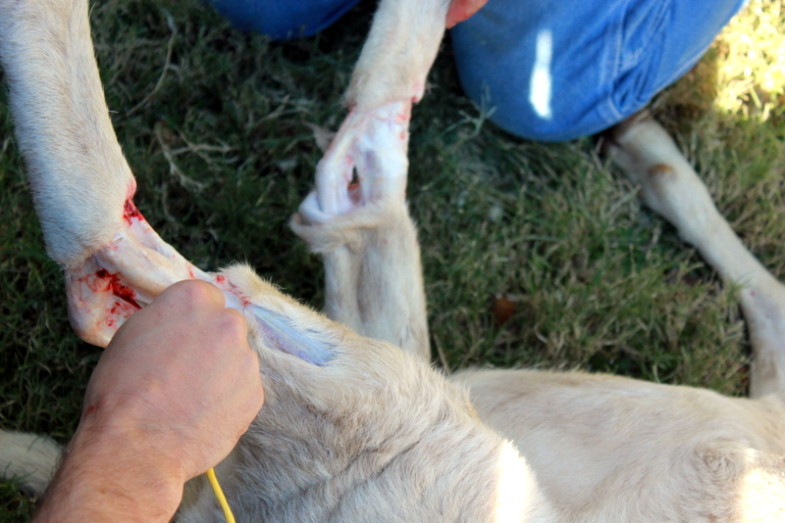
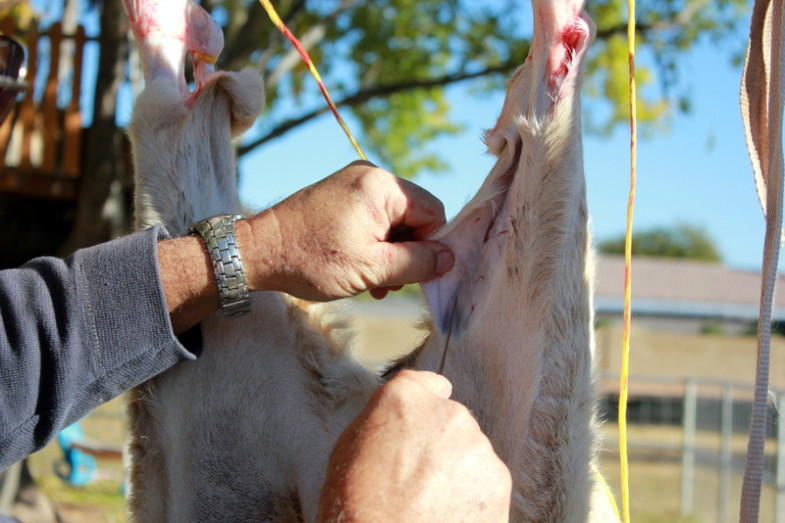
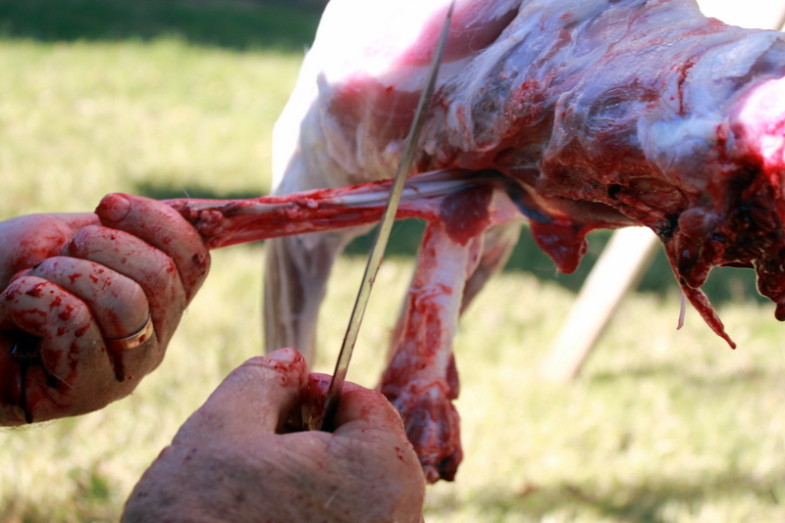
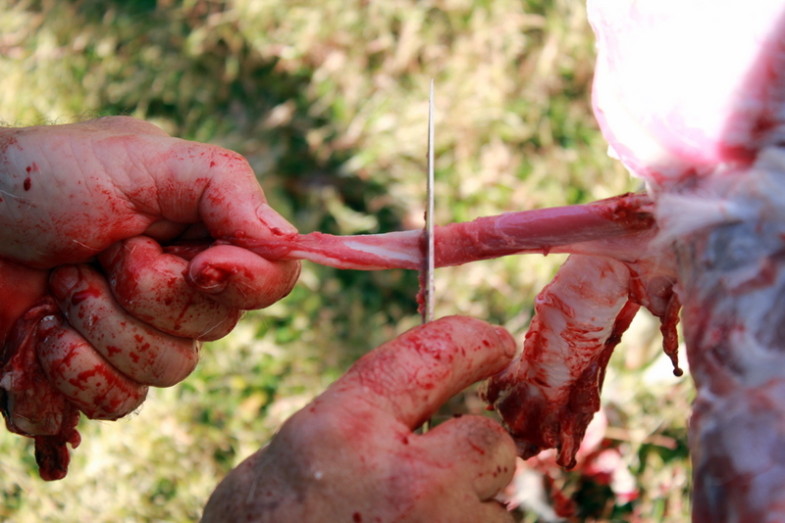
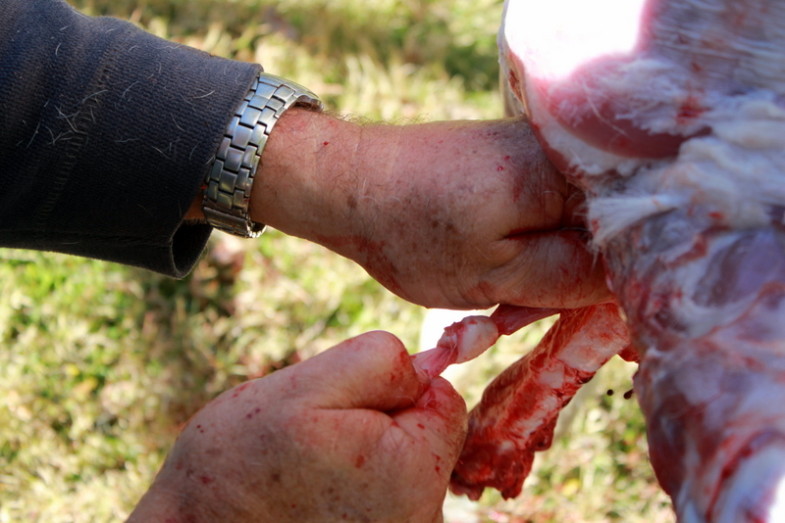
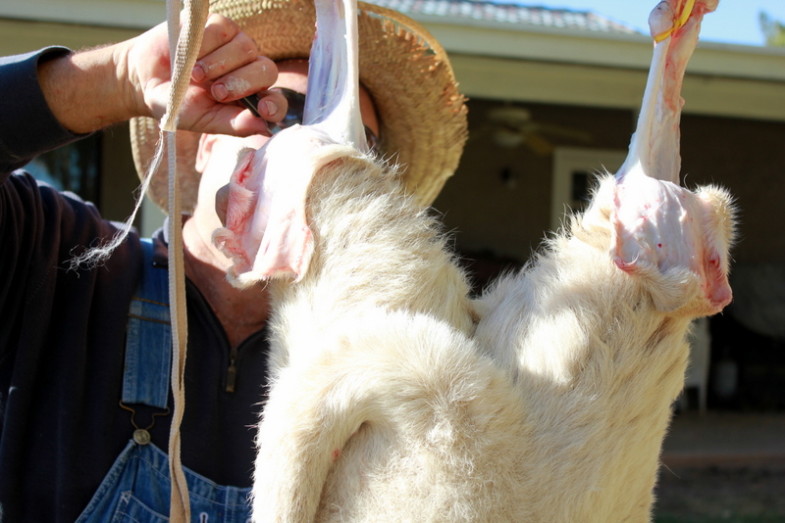
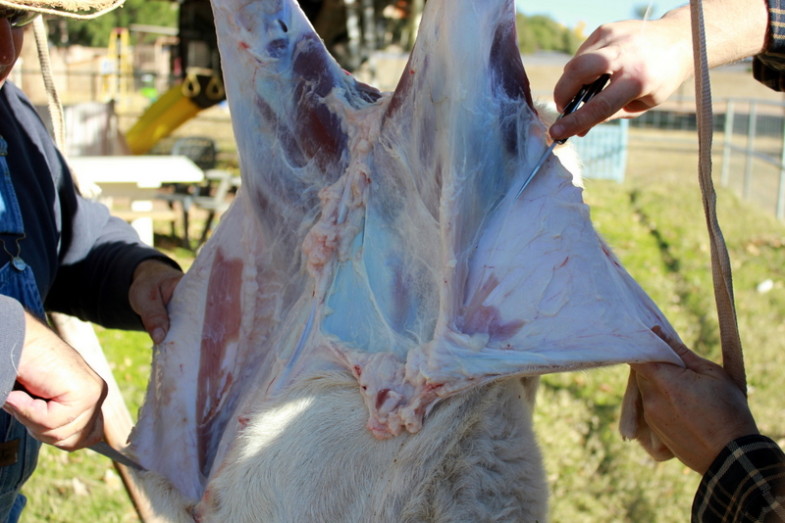
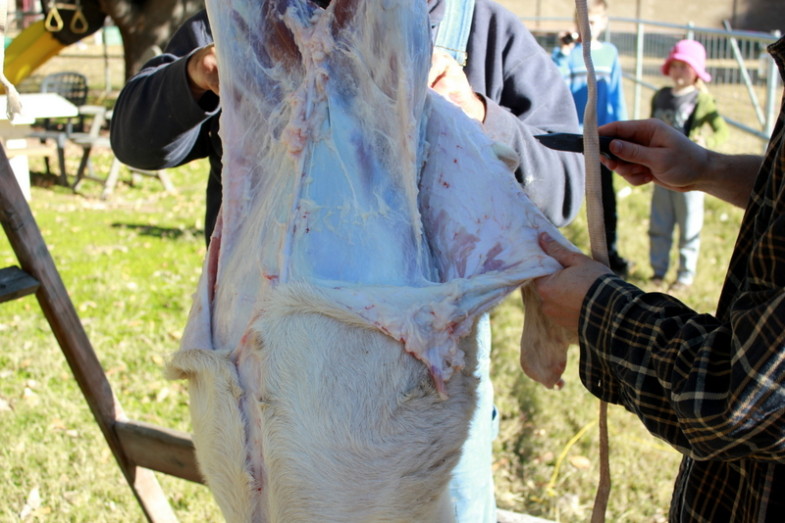
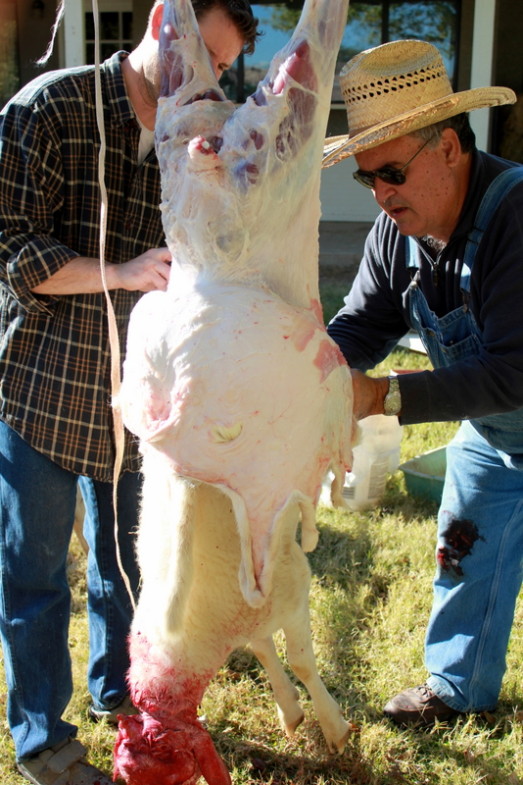
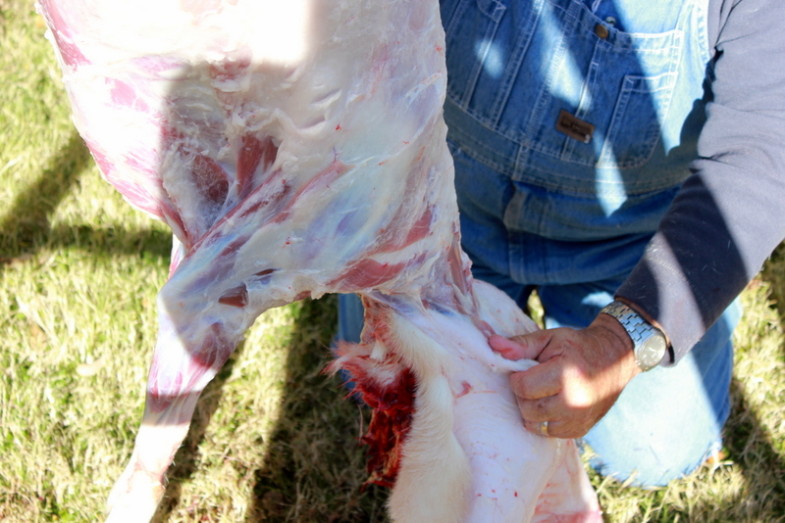
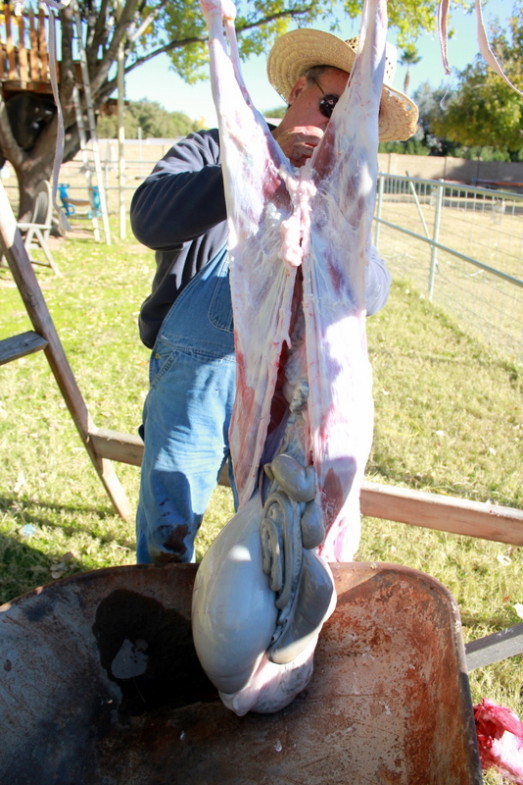
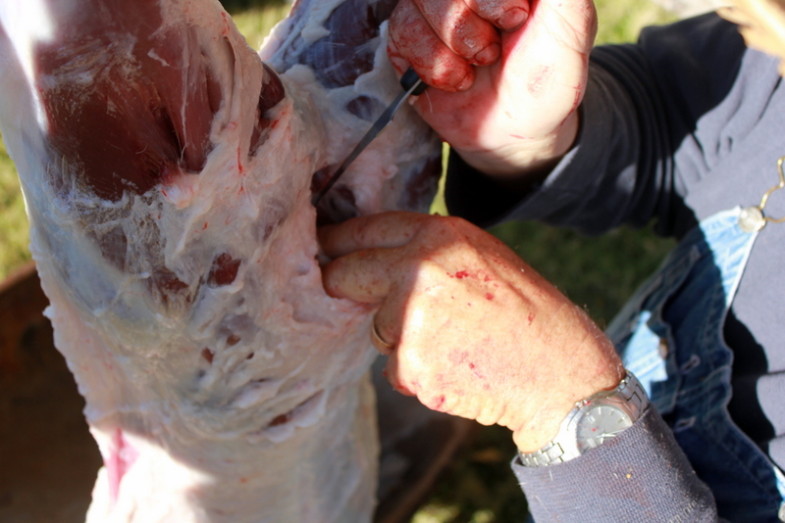
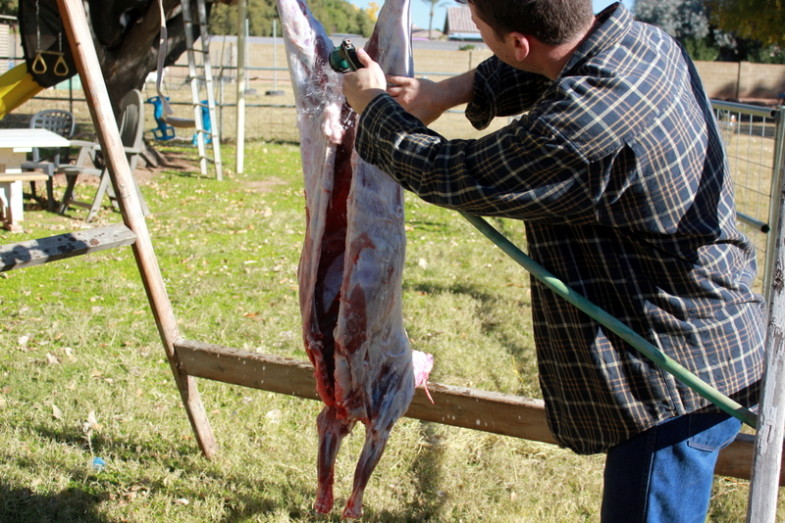
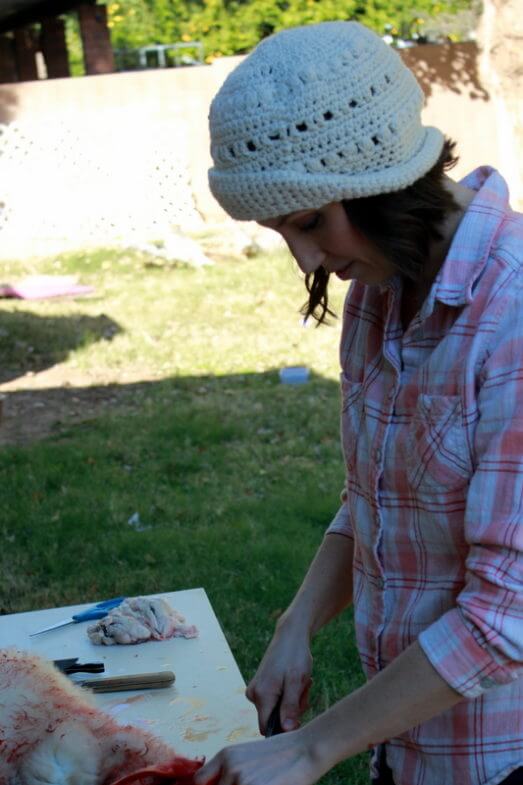
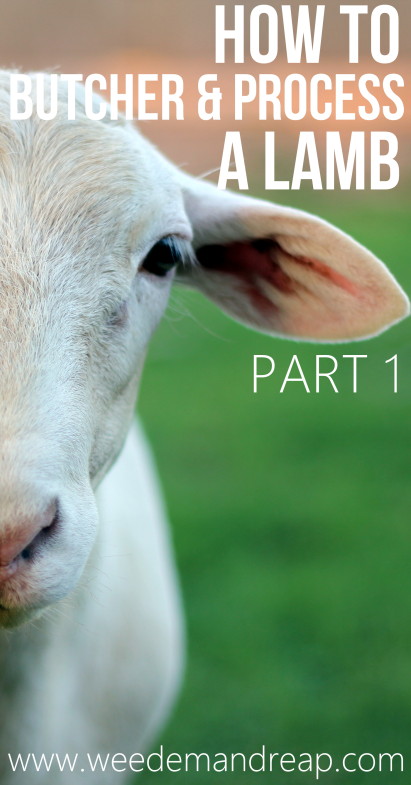


Great informative post on the entire process. Really helpful for those learning how to raise and butcher their own meat the old fashioned way.
I’m vegan and I think it’s great that you do everything yourself and minimize suffering for your animals. I personally prefer the idea of hunting to the idea of domestication, but I guess as long as you aren’t personally affected by the idea of caring for an animal and then killing it, I don’t see why it would be a problem.
I don’t see why people are so judgmental towards people raising their own animals for food when the real problem are people blindly buying horribly factory-farmed animal products, involving an unimaginable amount of suffering for the animals while also damaging the environment.
This is nothing in comparison. I wish I could be reassured that every meat eater ate this way…
I agree with Evamarie–well said! We try to eat meat sparingly, so the idea of raising an animal for meat, with gratitude and thanksgiving, is something that I want to experience. Although I have never butchered an animal before, I can imagine that there is a sort of reverence that accompanies that experience. Thanks for sharing DaNelle!
I came across this blog after looking for different methods of butchering sheep. You mentioned how the Native peoples (I’m assuming Navajo) have raised and used sheep for thousands of years. Sheep, cattle, horses, pigs, and chickens were brought over by the Europeans a little over 600 years ago. Sheep have become a major staple of our peoples lives, and we have thus integrated it into our tradition and culture. Pre-colonial forms of meat consisted mostly of native wild life.
I am Diné from the Eastern Agency and mutton is always available in my freezer. My family has a generous herd of about 12 ewes and three rams. I’ve come to realize how much more can be done with mutton outside of a roast or stew. I gleaned some valuable information from your post and I can recognize some Arizona methods. Thank you!
We process sheep and goats here on the farm. I was wondering how you process the head?
Depends on how you want to use the meat. My family eats everything in the head aside from the skin and horns. Our usual method is to burn the wool on all sides of the head. Then taking a twig or the back of the knife, we’ll scrape the burnt wool off until it’s a deep golden brown. After that, we’ll wrap the entire head in tinfoil and cook it underground for around 8-10 hours. You can cook it in the oven, but it has a very pungent smell that permeates everything. Once done we peel the skin away to expose the meat. This goes great with a tortilla, raw onions, and roasted green chile. It’s recommended that you peel the outer layer of the tongue off before eating. You also need to take the iris off the eye before eating. Lastly, don’t forget the brain, which has a very interesting texture that is both grainy and gooey.
I know this may not be an issue you care about, but sheep and goats can be prone to a condition called Scrapie, which is a prion “disease.” It isn’t really a disease in the sense of a bacteria or virus, but a scrap of protein that can cause spongiform encephalopathy in animals that pick up this bit of nasty self replicating protein. It causes very serious and always fatal degeneration of the neural cells and tissue in an animal. It’s seen in most animals (including wild ones) and human animals too. Only in humans it’s called Creutzfeldt-Jakob Disease. Cooking does not neutralize this protein bit, like it does with most viruses and bacteria. So it is generally advised that humans avoid consumption of the brain and nervous system of any animal which feeds from the ground or grazes. It’s one of thoses better safe than sorry things, since catching it is devastatingly and horribly fatal. You do NOT want to go out with it. Feed it to the pigs. Seriously, they tried to get pigs to catch it and had to work very hard to do it, and then it caused no ill effects. and no one eats pigs brains so…There is no natural prion disease in pigs. I’d raise pigs, but my HOA would definitely NOT allow it. A cute little lamb I might get away with.
Super informative, and exactly what I was looking for! I needed more info on large animal butchering for my novel (I’ve only ever dispatched a chicken, myself) and the magic of google brought me right to you. If I ever make it to print, I’ll be sure to thank you!
Hi Madeleine-
Glad it helped. Best of luck! Thank you -Bobbi (DaNelle’s Assistant)
if you plan on roasting the lamb whole do you need to let it hang/rest overnight?
The rule of thumb is either roast an animal right after you butcher or wait 3-4 days to let it age. Anything in between makes it tough.
Hello; I just discovered your site and really liked your explanation of this tender subject. I’m a former dairy farmer. Your slaughter method is very humane, When I traveled in Mongolia instead of skinning the head they quickly burned the hair off with a propane torch so they could eat the skin as well which is a delicacy. After grilling, the head was delicious. The Mongols also have an incredibly humane method of slaughter, the best I’ve ever seen. All animals should have the right to a good natural life and a dignified humane death.
Looks very similar to how we butcher deer. Hoping to add some sheep to our farm in the near future and I’ll be back to re-read this! Thanks!
I live near Santa Rosa, California and have not been able to purchase a single lamb head, for years. Being of Greek ancestry I was raised eating lamb and often the lamb heads. I am now 86 years young and still crave having a lamb head, on occasion, yet…cannot find anyone that sells them. Any thought on what I can do to get a source?Your blog just made me crave the head even more. Great work!
DaNelle,
I know this is a really old post, but I couldn’t help but asking. We are raising goats now, and I was wondering if the butchering process of goats is the same as lambs? They aren’t the same I know, but it seems it would be similar to me.
Thanks
Hi Eva, yes it’s exactly the same:)
Thanks DaNelle!
Stumbled across your blog while surfing for a good amateur guide for my first experience at this. Not being extemely interested in getting risky, expensive firearms with my three toddlers boys about, I was happy to be validated that you can peacefully, humanely and easily make do with a sharp knife.
Quick slice with a sharp knife and he just took it…like a lamb; never really seemed to be in pain, never cried out. This 5 mo old Dorper lamb had a whole carcass weight of 50 lbs and yeilded 25 lbs meat. It was really less gross than butchering chickens. II look forward to tasting and trying my other sheep as yearlings.
Oh, I’m glad you had such a good experience.
Dear DaNelle,
We are considering raising larger animals for meat. My big question is: What do you do with the innards, skin, etc. that you don’t eat? I can’t imagine just putting it in the trash.
I found you on Pinterest and I am so glad I did. Your pictures (tastefully done I might add) will be very helpful in our future!
Sincerely,
Lynda
Life on the Farmlet
We save as much as we can, and discard the leftovers. I’m sure there are more uses and we’ll discover them as we research more:)
Girl…you are crazy. I haven’t been on your sit for an awhile, so I didn’t see this post. Wow, you had your hands in all of that stuff. My hat is off to you brave woman. I think you are doing some great things. Don’t let the haters slow you down (especially if they are illiterate and can’t spell).
Thanks Todd!
You can grind up all the innards, skin, and bones for dog food; cook it or feed it raw.
Dogs love it and it’s very healthy! Farm dogs are more healthy than dogs fed commercial rations for this very reason!
If you don’t want to go through all that trouble, you can also just compost it. Dig a hold into the middle of your compost heap and bury it. 🙂
Hello!
I want to ask permission – could I please use your photos of the process in an art project? It’s just really difficult to find good quality photos of the process.
As long as you don’t publish them online, I’m okay with it:)
Dear Ms. Fairweather,
I could ask where you your “Think” about most farmers’ eduction levels i.e. the cream or what is below, (from these animals) but would you at least let us know if you eat meat? As far as the Brainwashing thing goes, please do not apply that to any particular group of people. We can all quickly scoop up a handful of people who have been completely brainwashed by their families, work environment, govt, etc. so that is another unfair accusation used here without much thought. We have all dealt with people near or far, or in intimacy, who we’ve become to understand as brainwashed. Debriefing is the fun part : )
But do you eat meat? Drink milk? Or are you vegan?
At the least, if you do not eat meat, than it us quite understandable why you would say this and there is no disputing it to you. The cream analogy would not apply either.
But if you do, please take a moment to think about what you are saying, take a look at the labels in your clothing and many of the other things around you in your own private Idaho.
I don’t know you, but I like you. 😉
Seriously, in this response you said everything I wanted to, but better than I could have.
Also, for vegans’ information, vegetable farming hurts more animals than raising domesticated animals for meat.
For every acre of crop farming, whether in the U.S. or elsewhere around the world, thousands if not millions of animals are either killed or driven from their habitat to protect the crops. Crop farmers hunt deer, and purposefully kill insect and rabbit pests to protect their crops. Most crops are fertilized with bone and blood meal byproducts from meat processing.
If you really think about it, raising an animal for meat actually harms less animals than crop farming.
Also, domesticated animals can be butchered completely or nearly pain-free, whereas in the wild, predators like canines, felines, primates, snakes, whales, etc. etc, kill to eat any way they can, causing MUCH more pain than butchering.
For the record, I am TOTALLY in favor of raising animals for meat. Who doesn’t like a big steak? 🙂
I think many farmers have less than a high scholl education and have been brainwashed bytheir families, for years, that it is ok to torture, disrespect life, and tear babies from their mothers, side, for what! If you actually educated yourselves you would be growing beans, rice or even flowers, veggies..and you might have some respect..
Actually, I wasn’t raised on a farm, I did the brainwashing myself 😉
Your response is priceless, DaNelle! 😉
For what it’s worth, I think the true brainwashing came in when the disconnection with where our food (be it meat or otherwise) comes from began 100 or so years ago. The very fact that most people would be turned off from a post like this PROVES the immensity of that disconnection. I’m not gonna lie — the photos in this post did not load for me due to a glitch with my internet connection, and the squeamish, city-girl part of me is actually a bit relieved. 😉 But I am tired of the brainwashing and disconnect, so I’m training myself to remember that it is okay — it is okay if butchering makes me feel squeamish right now and it is okay that in the future it hopefully won’t (as long as it is done with respect).
On a side note, thanks for sharing your homesteading experiences on this topic with us in such an honorable and courageous way. It means a lot. 🙂
I love your reply. I’m interested in Homesteading myself and I’ve found your site to be very informative. Your siute has also helped me with my self induced brainwashing.
Glad to help, Mark!
Love this post! One of my sons and started with chickens 2 years ago. This last December we butchered our pig. 🙂 I haven’t gotten into sheep. I have goats…that we don’t eat, and we just got our dairy cow. If she has a bull we will keep him for the freezer. It is all part of our life. I appreciate every aspect of it, and kinda feel sorry for those people who still want to believe that their food doesn’t come from a farm, but from neat, plastic wrapped packages at the store. Thank you for sharing!!
I’ve done a few goats & a lamb, but with help from my neighbor, as I couldn’t do the actual killing. When that was done, I had no problem getting in and helping with the gutting, skinning and cutting up the meat.
I also offer up a pray of thanks to the animal for giving it’s body to help feed & keep us healthy.
Interesting how you can’t help murder your sweet, innocent little beings that dont deserve this imprisonment and hate from humans
you are so messed up in the head. What the heck do you eat and feed your family?? Animals thank you very much. How stupid can you be to think this is cruel when it is natural. And most farmers have more than a high school diploma.. lets learn your facts missy before you go and diss others. thank you.
Fairweather, you are mistaken…there is no hate involved. It is our love for the land and animals that helps us give them a healthier and better life and provides us the same in return. All farmers are educated; however many of the older ones don’t suffer fools lightly. You need to do some serious unbiased research about how your store bought veggies are grown before you spew venom at others who truly understand the entire process of bringing healthy food to our table.
Thank you for sharing this. Sometimes I think bloggers stay away from these important articles because it is a more sensitive topic than baking something but it needs to be taught and learned. Like Jessica and Lisa I have butchered chickens but that information is much easier to find than information on processing bigger animals. Thank you again!
Why must it be learned? It is unnecessary
Fantastic blog!
My husband tans the hides from our goats, rabbits, and sheep. He salts the hides down, then brines them when he has enough hides accumulated.
I don’t know the whole process, but he researched online, and has tried a few methods of tanning/brining. Brine works best for us.
Do you use the skin of the lamb for anything? I am just wondering if there is a way to tan the hide and use it.
Tammie
We don’t because, well, we’ve never learned how to do that! Maybe one day we’ll get adventurous!
When pulling the skins off, it can get a little difficult to get a good grip to pull the skin off with. One thing I’ve used to help are pliers , preferably locking pliers. The locking version helps to avoid tiring your hands out. Some people use hand seemers (usually used for bending sheet metal) with a good gripping surface. Sometimes the pliers can tear the skin and hand seemers give you a broader grasp so you don’t tear skin as easily.
What a great blog post! I work at a butcher shop and we have a lot of people bring in their own farm killed animals, I will be suggesting they read your post so they can learn to do it correctly:)
what breed of sheep is this lamb? Good job!
I’ve butchered chickens, and it’s a solemn occasion every time. Lamb doesn’t look that different, except in scale. What do you do with the skin? Is there any demand for lamb leather?
We don’t do anything with the skin, there’s not really a demand for lamb leather in my area:)
Do you just throw it away, then? Just curious. 🙂
Yeah, we do just toss it.
Love your blog and way of life by the way!
Kudos to you guys! I don’t know if we could do that but maybe some day. We’ve butchered chickens the last 3 years but that’s it. Question, what breed of sheep do you have? And, if you ever have little goat wethers that you couldn’t sell have you butchered them? I’m hoping for nigerian dwarf goats this summer and wonder what to do with the kids that don’t sell.
Hi Jessica,
We have Katahdin sheep:)
Great job. I just finished doing 3 sheep on Sunday and they are now hanging in the garage. I will start to process the meat today. I like to age for about 4 days. We also have the Katahdin hair sheep. But also have added in some Dorper hair sheep for a meatier body. The meat is very flavorful and not at all like a “Mutton” “Wool” sheep. We usually do 2 year old or older as you get a nicer meat content. People look at me and think I am mean or crazy. But this is a way of life. We also raise our own pig, chickens and Turkey. Fun trying to be more self sustaining in a world of preservatives and mass marketed products. Thank you for sharing your life with us. 🙂
Thanks! Interesting Sara, you wait until 2 years to butcher? And the meat still tastes fine? I’ll have to consider that!